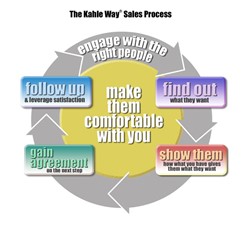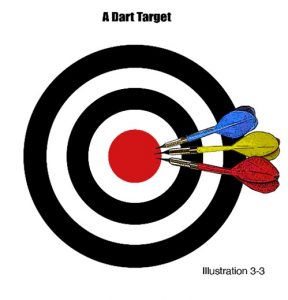All too often, salespeople are directed by the urgencies of the moment: A lead pops up, a customer calls with a problem or some paperwork to which you need to attend. They find themselves busily pursuing an agenda created by other people. They are busy, but too often with the wrong things.
The best salespeople, however, understand that sales happen as a result of methodically managing people through certain well-defined steps in a sales process. They have refined that process to the specifics of their selling situation, reflecting the uniqueness of their customers and their offerings, while at the same time building it on the infrastructure of the fundamental sales process. Here is an excerpt from my book, How to Sell Anything to Anyone Anytime, which describes that sales process.
Step One: Engage with the right people
“Engage” means to interact in some kind of communication. It can be face-to-face, over the phone, via email, or via a website. “Right people” means those people who have a need or interest in your product, and for whom the timing is right.
If you don’t engage with the right people, you spend all of your time in the wrong place. Sort of like trying to plant carrot seeds on a cement sidewalk. You can do everything else right, but it won’t matter.
Step Two: Make them comfortable with you
If they are going to believe what you say, you have to be somewhat credible, and they have to feel at least a bit comfortable with you. If they aren’t comfortable with you, they won’t spend much time with you, and the time they do spend will be guarded and tentative. They may be convinced to do business with you because of the fundamental attractiveness of your offer, but if they are not comfortable with you, it will be action taken against the grain. They will be forever uncomfortable and eager to find a replacement.
On the other hand, if they are comfortable with you, they won’t mind spending time with you. They’ll be much more open to sharing the information that is necessary for you to do a good job of crafting a solution. They’ll believe what you have to say. You’ll get the benefit of the doubt and they’ll be eager to share future opportunities with you.
Step Three: Find out what they want
Selling is not manipulating people so that they take something they don’t want. It is, instead, finding out what they already want, and appealing to that interest. The best salespeople excel at this step in the process.
I believe this step is the heart of selling – the essence of what sales are all about. I know that flies in the face of the routine practices of multitudes of salespeople, who believe that the end-all of their focus is to push their product.
You can proclaim the merits of your product to willing and unwilling listeners and web page visitors far and wide, attempting to sway them with the powerful features and advantages which your product offers over the competition. Or, you can focus on the customer, finding out what motivates him, what issues are important to him, what problems he has, what objectives he is trying to solve, what he looks for in a vendor, etc. That’s a better way.
Everything that comes before is designed to get to this understanding. And everything that you do after is based on this step. It is the fulcrum upon which the entire sales process pivots.
Step Four: Show them how what you have gives them what they want
Proclaiming your product’s features is the preferred routine of the mediocre salesperson. Personally and individually crafting your presentation to show the customer how what you have gives him what he wants is the mindset that, in part, defines the master salespeople.
If what you have doesn’t help them get what they want, you either have the wrong thing, or you are talking to the wrong person.
Step Five: Gain an agreement on the next step
Closing the sale is by far the most over-hyped phase of selling. If you have the right person, and you have uncovered something they want, and you have shown them how what you have gives them what they want, why wouldn’t they take the next positive step? It’s natural. You just need to help them define what that is and commit to it.
In more complex sales, there can be a series of appropriate next steps. They may need to test it, to evaluate it, to submit it to a committee, etc.
Every sales interaction has an assumed next step. If you call someone for an appointment, the next step is the appointment. If you present your solution to a decision-maker, the next step is the order. In between, there are thousands of potentially different sales calls, and thousands of potential action steps that follow the sales call.
The agreement is the ultimate rationale for the sales call and the aspect that makes it a “sales” call. A sales call is set apart from the rest of the interactions in this world by the fact that it anticipates an agreement.
Without an agreement, the process has been a waste of time. It is the ultimate goal of every salesperson, and of every sales process, and of every sales call.
Step Six: Follow up and leverage the transaction to other opportunities
After they buy, you then make sure they were satisfied, and you assume that, because they are satisfied, they will want to do other business with you and will want to let their friends know about you as well. Sounds simple, and it is.
This is the step of the sales process that is most commonly neglected. Most salespeople are so focused on making the sale they neglect to consider that their real purpose is to satisfy the customer. And that extends beyond just the sale itself.
The sales call on the customer, made after the sale is complete, delivered, and implemented by the customer, is one of the most powerful sales calls available. In it, the salesperson seeks assurance that the customer is satisfied, and then leverages that affirmation to uncover additional opportunities within the customer and/or referrals to people in other organizations.
Here’s a graphic representation of the process. Notice, first, that each step occurs within the framework of the “right people.” In other words, if you do all the right things, but do them with the wrong people, you’re not even on the diagram. It’s an exercise in futility and a waste of your time.
Then notice that step two, make them comfortable with you, is in the center of the diagram, touching every other step. While it must happen early in the sales process, it must be continually nurtured throughout the process. At any point in the process, your customer can grow leery or irritated with you, and that disrupts everything.
You Can Do Each Step Better
It’s one thing to be able to do each step, and it’s another to be able to do each step better! Just like every other field of human endeavor, there are the average performers, and there are those who do it better!
Here’s an example. I love to golf. But I am, at best, an average golfer. I’m not nearly as good as many of the golfers in my league. I know I can golf better – after all, many of them are better. Every year I expect that I will golf a bit better. But, alas, I just don’t have the time and energy to put into becoming better. So, while I am an average golfer, I could, if I chose, become better.
So, too with every one of these steps in the process. There is adequate performance, and then there is better performance. But it’s not an either/or kind of situation. There are degrees of better. There’s lots of room between me and Tiger Woods.
Think of your performance on each step as being like a dart target. You know the kind I’m thinking about – it is split into 6 or 8 pie-shaped slices, and has a number of rings, each smaller than the one immediately to the outside of it. The bull’s eye, in the middle of the target, has the greatest scoring potential.
When you are playing darts, you throw your darts at the target, and the closer your dart strikes to the bull’s eye, the more points you score. If your dart strikes at the outermost ring, you score just a few points. But you do many times better if you hit the bull’s eye.
Now, every time you engage in one of the process steps, it’s like throwing a dart at the target. You can hit the outer ring and score a few points or hit closer to the bull’s eye and score more. You can do each step of the process, or you can do each step better. And, like the ever-smaller rings of the target, there are degrees of better. The bull’s eye is always the vision of perfection.
WACSO-4




Trackbacks/Pingbacks